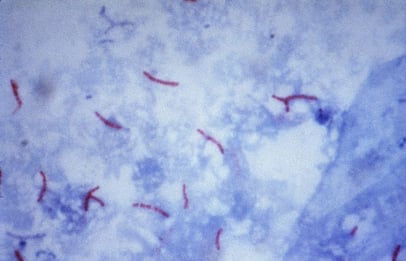Bacteria research has become an increasingly important focus for researchers in the biomedical community as of late. From studying antibiotic resistant superbugs at UCSD to investigating bacterial diversity at Rutgers University, researchers are using these microscopic organisms to provide insight into diseases that plague our society.
Most recently, researchers at the University of Massachusetts, Amherst have focused their efforts on an especially dangerous form of bacteria: Mycobacteria. These particularly durable bacteria have a characteristically thick cell wall and are responsible for many difficult to treat diseases like Tuberculosis and Leprosy (Mycobacterium tuberculosis is pictured below).
(Image Courtesy of Wikimedia and CDC / Dr. George Kubica)
Dr. Yasu Morita, a molecular microbiologist at UMass, and his doctoral student Jennifer Hayashi wanted to investigate these varieties of bacteria due to their especially durable nature which has made eradicating them a very slow process.
Their study, published in Proceedings of the National Academy of Sciences, show some highly compelling insights into how Mycobacterial cells grow. Morita and Hayashi focused their efforts on a model species of this pathogen, Mycobacterium smegmatis, to further their knowledge on basic structure and mechanistic growth. What they discovered is a distinct domain located on the bacteria's plasma membrane made up of 300 different proteins as well as over 600 individual proteins in the non-domain membrane vicinity associated with cell growth. This identified domain provides massive implications for the future of disease treatment, as Dr. Morita acknowledges.
“We hope that discovering this dedicated domain will one day lead to methods of inhibiting bacterial growth, but the real problem of mycobacterial diseases is that these particular bacteria can lie dormant for long periods without active growth. Knowing more about this newly discovered membrane domain could someday let us understand how they control their own growth and how they go dormant to hide in the body.”
This research was supported by the Mizutani Foundation and the Potts Memorial Foundation in addition to a UMass Amherst Graduate School dissertation grant awarded to Hayashi.
This study is just one of the many pioneering research endeavors currently headed by research teams at the University of Massachusetts, Amherst. Another recently published Science Market Update article highlighted a UMass research team's discovery of a potential new Ebola treatment strategy utilizing a surface protein vulnerability.
The University of Massachusetts' high level of research activity is supported annually by around $19 million from the National Institutes of Health and boasted a Life Science R&D expenditures total of nearly $70 million in 2014. UMass is also currently undergoing a massive five-year, $1.4 billion construction and renovation project on its campus featuring a recently opened $160 million Life Science Laboratories Building.
For more news on the state-of-the-art research and new innovations at the University of Massachusetts, Amherst, see additional articles below previously featured on Science Market Update:
UMass Researchers Hook Nearly $1M for Research on the Hookworm GenomeUMass Harvests $1.5M from USDA for Food Science Bioresearch
$1.5M Granted to UMass for Breast Cancer Research
If you are a lab equipment or chemical supply company interested in marketing to researchers at this highly active campus, consider attending Biotechnology Calendar, Inc.'s upcoming Amherst BioResearch Product Faire™ Event on July 13, 2016.



